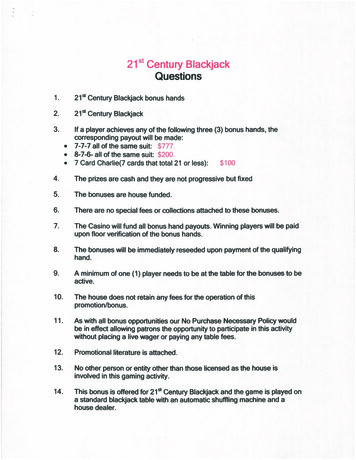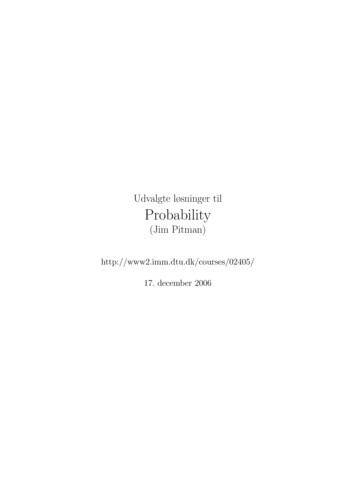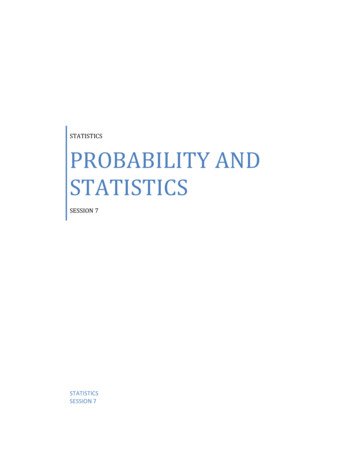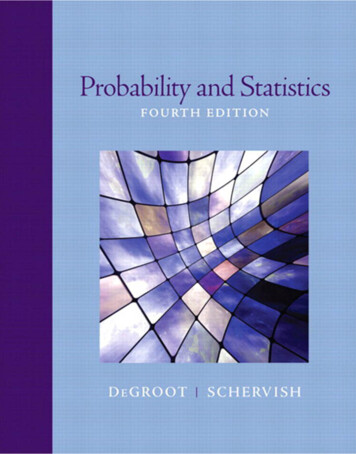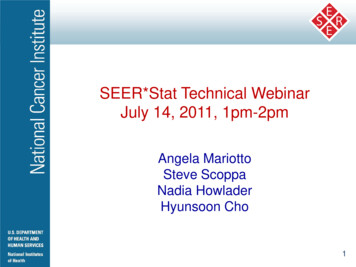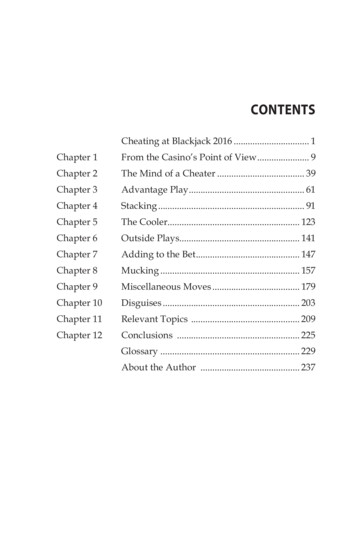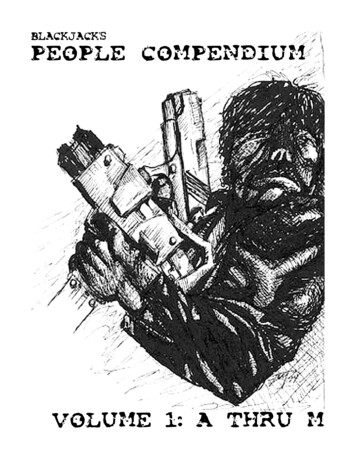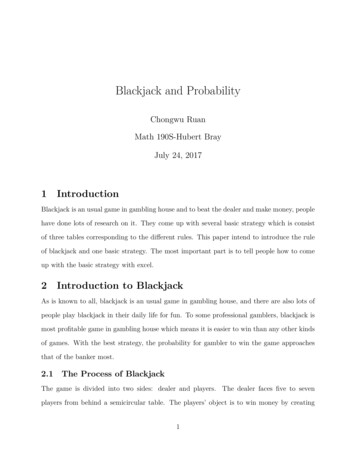
Transcription
Blackjack and ProbabilityChongwu RuanMath 190S-Hubert BrayJuly 24, 20171IntroductionBlackjack is an usual game in gambling house and to beat the dealer and make money, peoplehave done lots of research on it. They come up with several basic strategy which is consistof three tables corresponding to the different rules. This paper intend to introduce the ruleof blackjack and one basic strategy. The most important part is to tell people how to comeup with the basic strategy with excel.2Introduction to BlackjackAs is known to all, blackjack is an usual game in gambling house, and there are also lots ofpeople play blackjack in their daily life for fun. To some professional gamblers, blackjack ismost profitable game in gambling house which means it is easier to win than any other kindsof games. With the best strategy, the probability for gambler to win the game approachesthat of the banker most.2.1The Process of BlackjackThe game is divided into two sides: dealer and players. The dealer faces five to sevenplayers from behind a semicircular table. The players’ object is to win money by creating1
card totals that turn out to be higher than the dealer’s hand but do not exceed 21 (“busting”/“breaking”), or alternatively by allowing the dealer to take additional cards until he/shebusts.(a) Initial deal(b) player action(c) dealer’s hand revealed(d) bets settledall four pictures are from wikipideaAt the beginning of each round, each player can place his/her bet in the “betting box” ateach position in play. The dealer and players get their initial two cards and the dealer’s handreceives its first card face up and its second card face down (the hole card), which the dealerpeeks at but does not reveal unless it makes the dealer’s hand a blackjack(an ace and 10).While the both two cards of each player are usually visible to any other players. Then singlecards are dealt to each players clockwise from the dealer’s left. On their turn, players must2
choose whether to “hit” (take a card), “stand” (end their turn), “double” (double wager,take a single card and finish), “split” (if the two cards have the same value, separate themto make two hands) or “surrender” (give up a half-bet and retire from the game). The moredetailed meaning of these player decisions will be listed later in this part. After all boxeshave finished playing, the dealer’s hand is resolved by drawing cards until the hand bustsor achieves a value of 17 or higher (a dealer total of 17 including an ace, or “soft 17”, mustbe drawn to in some games and must stand in others, and as the statistic theory shows, theformer is more favorable to players).The dealer never doubles, splits, or surrenders.2.2The Rule of Blackjack Number cards count as their natural value; the jack, queen, and king (also known as“face cards” or “pictures”) count as 10; aces are valued as either 1 or 11 according tothe player’s choice. If the hand value of player exceeds 21 points, it busts, and all bets on it are immediatelyforfeit. If the dealer busts, all remaining player hands win. If the dealer does not bust, eachremaining bet wins if its hand is higher than the dealer’s, and loses if it is lower. If a player receives 21 on the 1st and 2nd card it is considered a “natural 21” or“blackjack” and the player is paid out immediately unless dealer also has a natural, inwhich case the hand ties. In the case of a tied score, known as “push” or “standoff”, bets are normally returnedwithout adjustment. A blackjack beats any hand that is not a blackjack, even one with a value of 21. An outcome of blackjack vs blackjack results in a push. Wins are paid out at 1:1, orequal to the wager, except for winning blackjacks, which are traditionally paid at 3:23
(meaning the player receives three dollars for every two bet). Blackjack games almost always provide a side bet called insurance, which may be playedwhen dealer’s upcard is an ace. Additional side bets, such as “Dealer Match” whichpays when the player’s cards match the dealer’s up card, are sometimes available.2.3Player Decisions Hit: Take another card from the dealer. Stand: Take no more cards, also known as “stand pat”, “stick”, or “stay”. Double down: The player is allowed to increase the initial bet by up to 100 % inexchange for committing to stand after receiving exactly one more card. The additionalbet is placed in the betting box next to the original bet. Some games do not permit theplayer to increase the bet by amounts other than 100 %. Non-controlling players maydouble their wager or decline to do so, but they are bound by the controlling player’sdecision to take only one card. Split: If the first two cards of a hand have the same value, the player can split theminto two hands, by moving a second bet equal to the first into an area outside thebetting box. The dealer separates the two cards and draws an additional card on each,placing one bet with each hand. The player then plays out the two separate hands inturn; except for a few restrictions, the hands are treated as independent new hands,with the player winning or losing their wager separately for each hand. Occasionally,in the case of ten-valued cards, some casinos allow splitting only when the cards havethe identical ranks; for instance, a hand of 10-10 may be split, but not one of 10-king.However, usually all 10-value cards are treated the same. Doubling and further splittingof post-split hands may be restricted, and blackjacks after a split are counted as nonblackjack 21 when comparing against the dealer’s hand. Hitting split aces is usually4
not allowed. Non-controlling players may follow the controlling player by putting downan additional bet or decline to do so, instead associating their existing wager with oneof the two post-split hands. In that case they must choose which hand to play behindbefore the second cards are drawn. Some casinos do not give non-controlling playersthis option, and require that the wager of a player not electing to split remains withthe first of the two post-split hands. Surrender (only available as first decision of a hand): Some games offer the optionto “surrender”, usually in hole-card games and directly after the dealer has checkedfor blackjack (but see below for variations). When the player surrenders, the housetakes half the player’s bet and returns the other half to the player; this terminates theplayer’s interest in the hand.31How to Play BlackjackAs we can see, blackjack is not that complex. To win the game and make more money, allwe need to do is remember the basic strategy, which is consist of three tables.3.1The Basic StrategyEach blackjack game has a basic strategy, which is playing a hand of any total value againstany dealer’s up-card, which loses the least money to the house in the long term.An example of basic strategy is shown in the table below, and includes the followingparameters:2 Four to eight decks The dealer stands on a soft 17 A double is allowed after a split1from wikipedia“4-Deck to 8-Deck Blackjack Strategy - Wizard of Odds”. Wizard of Odds Consulting, Inc. Retrieved 30April 2014.25
Only original bets are lost on dealer blackjackfrom wikipediaKey:6
S Stand H Hit Dh Double (if not allowed, then hit) Ds Double (if not allowed, then stand) SP Split SU Surrender (if not allowed, then hit)3.23.2.1How to Make the Table of Basic StrategyProbability of DealerTo begin with, we will deal with the probablity of dealer. The outcome of dealer’s hand isbust and 17 21. That means we need to compute the probablity of each outcome when theface up card of the dealer is 2 10 and ace. This can clearly form a table called “dealer”. Wewill use the method of recursion. For instance, if we have already known the probabilitiesthat dealer’s outcome is 17 when the card in hand is 4 12 and soft 13. Then we can get theprobability that dealer’s outcome is 17 when the hand is 2.To achieve this, we need two auxiliary tables. Let first one be “hard”. Its column isconsist of 2 31 without ace and the row is the same as “dealer”. Let the other one be “soft”.Its column is consist of 12 31 and the row is also the same. We can easily initialize the twotable as following:hard-17
hard-2softLet Py (x) be the probability that the dealer’s outcome is y when the hand is x.In “hard”, it is easy to understand that when the hand is 17, the probability that theoutcome is 17 is 1, and when the hand is 22 or even higher, the probability for the dealerto bust is 1. In “soft”, the column 22 31 is just the same as the column 12 21 in “hard”.Apply the formula (1) to every blank in “hard” column 2 16.Pyhard (x)91 hardP(x n) 4Pyhard (x 10) Pysof t (x 11)) (13 n 2 y(1)Because there are four cards standing for 10, so the coefficient of Pyhard (x 10)is 4.As for the blank in “soft” column 12 16, we can apply the formula (2):Pysof t (x)91 sof tPy (x n) 4Pysof t (x 10)) (13 n 1(2)Now, we have the two auxiliary tables ready, so we can start to deal with the “dealer”.Because it is impossible to have a blackjack when the face up card is 2 9, so the “dealer”column 2 9 is just the same as the “hard” column 2 9. As for the column 10, we need to8
exclude the possibility that the dealer gets an ace, so the formula will bePydealer (10)191 hard (Py (x) 4Pyhard (20))12 x 12(3)As for the column ace, we need to exclude the possibility that the dealer gets 10, so theformula will bePydealer (ace)201 sof tP(x) 9 x 12 y(4)So, we get the “dealer” table:dealer3.2.2Expected Value when StandingIn this part, we will discuss the probability for player to win when they choose to stand. Wewill also need two tables. The first one is “hard-S” whose column is consist of 2 10 and aceand row is consist of 4 31. Let each blank be Pxhard S (y) which means the expected valueof player when the dealer’s face up card is x, the hand of player is y and player chooses tostand. For instance, when the hand of player is 4 and face up card is 2, the only way fordealerplayer to win is that the dealer busts. So we can get P2hard S (4) Pbust(2). And the samething will happen when y 5 16. And when y 17 21, we will have the formula belowdealerPxhard S (y) Pbust(x) z yPzdealer (x) Pzdealer (x)(5)z ySo it is easy to see that the value can be negative. As for y 21, the player just busts sohe/she is bound to lose and Pxhard S (y) 1.So we get the “hard-S” as below9
hard-SThe other table is soft-S. The row of “soft-S” is consist of 12 31 and the column is justthe same as “hard-S”. It is clear to everyone thatPxsof t S (y) Pxhard S (y),y 12 21 P hard S (y 10), y 22 31.xSo we get “soft-S” as below10(6)
soft-S3.2.3Expected Value when HittingIn this part, we will discuss similarly to the former part. We will give two table which arehard H/sof t H“hard-H” and “soft-H”. Let each blank be Px(y) which means the expected valueof player when the dealer’s face up card is x, the hand of player is y and player chooses tohit. And we will also have another two table which are “hard-hs” and “soft-hs”. They aredefined as belowPxhard hs (y) max(Pxhard H (y), Pxhard S (y))(7)Pxsof t hs (y) max(Pxsof t H (y), Pxsof t S (y))(8)Because the player have to make the choice with higher expected value.Then we get the formula 9 1 hard hs Px(y n) 4Pxhard hs (y 10) Pxsof t hs (y 11)), y 4 20 (13hard Hn 2Px(y) 1,y 21 31.(9)11
and 9 1 sof t hs Px(y n) 4Pxsof t hs (y 10)), y 12 21 (13n 1Pxsof t H (y) hard hs Px(y 10),y 22 31.So we get the four tables as belowhard-H12(10)
soft-Hhard-hs13
soft-hsThen we just compare “hard-H” and “hard-hs”; compare “soft-H” and “soft-hs”. In thesituation that the value of “hard-H” equal to “hard-hs”, then we choose to hit, otherwise wechoose to stand. The same thing will be done to “soft-H” and “soft-hs”.Then we can get thetablebasic strategy considering only standing and hitting-hard14
basic strategy considering only standing and hitting-soft3.2.4Expected Value when DoublingWe deal with two table named “hard-D” and “soft-D” in this part. As the rule shows, wecan know that these two table is just based on “hard-S” and “soft-S” because when doubling,player gets one card only and can not hit again. We get the “hard-D” by applying thefollowing formula 9 2 hard S (Px(y n) 4Pxhard S (y 10) Pxsof t S (y 11)), y 4 11 13 n 2 9hard D2 hard SPx(y) (Px(y n) 4Pxhard S (y 10)),y 12 21 13 n 1 2,y 22 31.(11)The “soft-D” is given by the formula 9 2 sof t S Px(y n) 4Pxsof t S (y 10)), y 12 21 (13sof t Dn 1Px(y) P hard D (y 10),y 22 31.xThen we get the two table15(12)
hard-Dsoft-DWith “hard-D”, “soft-D”, “hard-hs”, “soft-hs”, we can make the two tables “hard-hsd”16
and “soft-hsd” which is defined byPxhard hsd (y) max(Pxhard H (y), Pxhard S (y), Pxhard D (y))(13)Pxsof t hsd (y) max(Pxsof t H (y), Pxsof t S (y), Pxsof t D (y))(14)hard-hsd17
soft-hsdCompare“hard-hsd” and “soft-hsd” with “hard-S”, “soft-S”, “hard-D”, “soft-D”, we cangetbasic strategy considering only standing, hitting and doubling-hard18
basic strategy considering only standing, hitting and doubling-soft3.2.5Expected Value when SurrenderingThis situation is quite easy, so we will just take a quick look. The “hard-R” and “Soft-R”will be likehard-R19
soft-RThen we can also get “hard-hsdr” and “soft-hsdr”. Through comparing, we can find thatbasic strategy considering standing, hitting, doubling and surrendering-hardand the soft one stays the same.20
3.2.6Expected Value when SplittingTo make things easier, we assume that player won’t split again after splitting. In this case,we will deal with a table “pair” whose column is consist of 2 10 and ace and row is pairs of2 10 and ace. As for y 2 10, we can get thatPxpair y92 hard hsd ((y n) 4Pxhard hsd (y 10) Pxsof t hsd (y 11))P13 n 2 x(15)However, things are kind of different with ace, because player can get only one card aftersplitting aces. SoPxpair (ace)202 sof t S (Px(y) 4Pxsof t S (y))13 y 12(16)We get “pair” as belowpairThen we can determine whether to split or not by compare the expected value of splittingthe pair of x and hard 2x. So we have the table “best” defined byPxbest (y) max(Pxpair (y), Pxhard hsd (2y)), y 2 10 max(P pair (y), P sof t hsd (12)),xx21y ace.(17)
bestCompare the “pair” and “best”, we can get “split” in which “Y” shows that you shouldsplit and “N” not.split4ConclusionAfter all these analysis, we can clearly learn how the basic strategy for blackjack is come upwith and everyone can draw these three tables by excel within a short time. It can also helpus to really understand the principle of mathematics behind the utube.com/watch?v idB-7FUaC-g[3]https://www.youtube.com/watch?v jCF-Btu5ZCk[4]Bringing Down the House. Ben Mezrich.22
[5] Thorp, Edward O. (1966) Beat The Dealer, Vintage Books, a Division of Random House,ISBN 978-0-394-70310-7.[6]“4-Deck to 8-Deck Blackjack Strategy - Wizard of Odds”. Wizard of Odds Consulting, Inc.Retrieved 30 April 2014.[7] “4-Deck to 8-Deck Blackjack Strategy - Wizard of Odds”. Wizard of Odds Consulting,Inc. Retrieved 30 April 2014.23
people play blackjack in their daily life for fun. To some professional gamblers, blackjack is most profitable game in gambling house which means it is easier to win than any other kinds of games. With the best strategy, the probability for gambler to win the game approaches that of the banker most. 2.1 The Process of Blackjack

